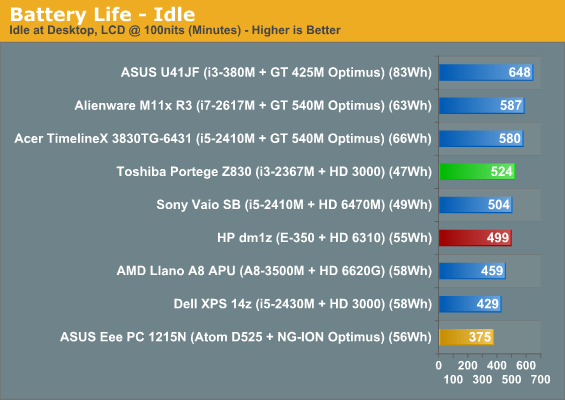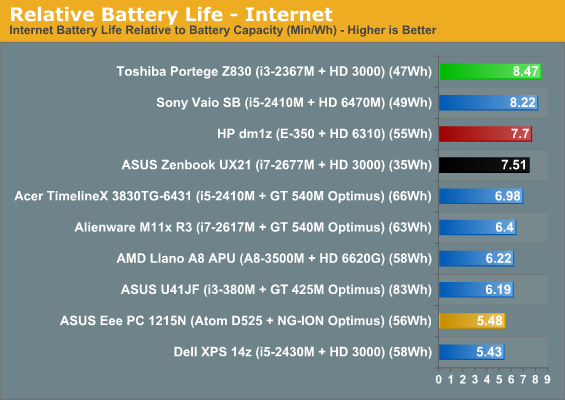Toshiba Portege Z835: A New Ultrabook Appears
by Dustin Sklavos on November 16, 2011 2:50 AM EST- Posted in
- Laptops
- Intel
- Toshiba
- Sandy Bridge
- Ultrabook
Battery Life, Heat, and Noise
Despite the incessant griping about the pokey Intel Core i3-2367M beating at the heart of the Toshiba Portege Z830, there's one place where a low-powered processor can pay dividends: battery life. The Z830 may have a weaker processor than the competing ASUS Zenbook UX21, but it also has a bigger battery. Check out this running time.






For sheer running time, the Portege Z830 lives up to the promise of ultrabooks, being an incredibly mobile notebook that lasts for a long time off the mains. When you look at the relative battery life, things get even better, with even the Optimus-enabled ASUS Eee PC and HP's E-350-based dm1z putting in weaker showings. Intel's CULV chips have historically been big winners, and suddenly the i3-2367M doesn't look so bad anymore: it's faster in every way than Atom or Zacate, and more frugal with power to boot. That said, the Z830 also benefits from having an mSATA SSD which is also going to sip power.

All that battery life wouldn't amount to much if the Z830 was noisy or hot in the process, but surprisingly it's neither of those things. The fan has a very low whine when the system is idling that isn't particularly intrusive, and while that whine does increase in volume under load, it's still nowhere near as irritating as the fan noise is on most notebooks. Better still, despite the thin, flimsy chassis, the Z830 remains fairly cool to the touch as well. During our stress testing loop, no hot spots really surfaced: this is a very cool, very quiet notebook that's definitely fine for using as an honest to goodness laptop.










76 Comments
View All Comments
r3loaded - Wednesday, November 16, 2011 - link
Amen to that. I also find it difficult to understand why it's so hard for them to put an IPS screen on them either. Practically every tablet that wants to be taken seriously has such a screen, yet it's a rarity outside of Lenovo/HP's top-end models. They shouldn't moan about cost either - it's a premium product, it deserves premium components and hence should have a premium price (which I and many others are ready to pay for).Tablets have 1280x800 IPS screens in a 10-inch form factor. We shouldn't have to put up with 1366x768 TN in a premium 13-inch ultra portable in 2011/2012.
solipsism - Wednesday, November 16, 2011 - link
IPS costs more money and users more power. On a 7" or 10" display that isn't too bad, especially when you powering it off ARM, but consider a proper notebook with a 13", 15," or 17" IPS panel. Thing gets a lot tricker.This will eventually change just as HiDPI resolutions on notebooks will eventually change, but that time just isn't hear yet. You can look at Apple's limited product line for examples: iPHone and iPad are iPS, iMacs and Cinema Displays are IPS, notebooks are all TN.
Penti - Thursday, November 17, 2011 - link
15" HP's with IPS-panels uses panels specced to 15W for example. You can't really use something that aren't manufactured.Narrlok - Wednesday, November 16, 2011 - link
ASUS UX31 Zenbook1600*900 on 13.3"
- check
Super good contrast and good brightness
- super high brightness like the MBA according to Anand's review of the UX21, contrast suffers though
Offer matte and glossy
- nope, no other alternatives either currently :( Sony does offer Vaios with a matte 13.1" screen with a 1600*900 resolution
medi01 - Wednesday, November 16, 2011 - link
16:9 and 16:10 screens suck badly. Bring good old 4:3 back and I'm sold.tzhu07 - Wednesday, November 16, 2011 - link
Are you 65 years old or something?HMTK - Wednesday, November 16, 2011 - link
No, he probably wants to do other things than watch movies. Like... work.JoeMcJoe - Wednesday, November 16, 2011 - link
Exactly.16:9 display ratios even on desktop monitors aren't the best for working on.
tzhu07 - Wednesday, November 16, 2011 - link
Oh really? I think my 2560 X 1440 desktop monitor suits me just fine for poductivity work. But then again, once you get up to the 2560 spec, 1440 or 1600 is plenty.MrSpadge - Wednesday, November 16, 2011 - link
My 1920x1200 IPS at work is also very nice for work. And with enough vertical space you can actually start to use the horizontal space by not running everything full screen.MrS